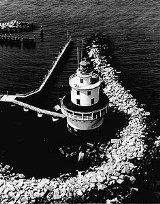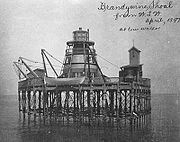
Brandywine Shoal Light
Encyclopedia
The Brandywine Shoal Light is a lighthouse on the north side of the ship channel in Delaware Bay
on the east coast of the United States
, west of Cape May, New Jersey
. It was the site of the first screw-pile lighthouse
in the United States.
was stationed near the shoal starting in 1823; this ship, known as Lightship "N", lasted until 1859, despite an 1838 inspection report characterizing it as being in poor repair. It remained at this station until 1850, with one interruption. In 1827 the first attempt was made to place a fixed light on the shoal. A wood pile structure, it lasted barely a year before heavy seas tore it down. An abortive project, begun in 1835, to design a light on a stone pier at the site was cancelled when the cost proved prohibitive.
The construction of the Maplin Sands Lighthouse in 1838 attracted the attention of American lighthouse designers, who saw the screw-pile
technology it introduced as means both to economy of construction and to the simplification of placing foundations in soft bottoms. Major Hartman Bache, who had devised the cancelled stone pier plan, was directed to try the new technique, and assisted by Lt. George Meade
he initially constructed a conical iron structure resting on nine piles. This structure was first lit in 1850. It became evident that this was not adequate to resist moving ice, and more piles were sunk in a sort of fence around the light; over the next eight years, sixty-eight piles were placed around the light, and a wooden platform was laid across them. The lighthouse proper rose out of the center of the platform as a short tower.
 This light was fitted with a third-order Fresnel lens
This light was fitted with a third-order Fresnel lens
in 1851, only the third American light to receive the innovation. It was used in a test by the then-nascent Lighthouse Board in which its light was compared with those of the Cape Henlopen
and Cape May lights, both fitted with the reflector schemes typical of US lights of the day. The greater brightness of Brandywine Shoals beacon, even though it was much further away from the test point than the other two, was a nail in the coffin for the reflector system, and the board quickly went about installing Fresnel lenses in all lighthouses upon assuming authority in 1852.
The light survived into the next century, but its cramped facilities and concerns about corrosion of the piles led the Lighthouse Board to obtain an appropriation to construct a caisson light at the site. This light, completed in 1914, featured a reinforced concrete superstructure on a cast iron and concrete caisson, resting upon wooden and precast concrete piles. The superstructure of the old light was removed, but the platform remained into the 1950s, used by the Navy
for various purposes. In support of this, a small artificial harbor was constructed using a partial circle of riprap; it remains in place, though the last traces of the old light have since been removed.
The Fresnel lens was moved from the old light to the new when the latter was completed, and has since been transferred to the Tuckerton Seaport
museum, where it is on public display. The light was automated in 1974, by which time it was the last manned station on Delaware Bay. It continues to serve as an active aid to navigation. The lighthouse is listed on the National Register of Historic Places
(reference number 06000943).
In June 2011, the General Services Administration
made the Brandywine Shoal Light (along with 11 others) available at no cost to public organizations willing to preserve them.
Delaware Bay
Delaware Bay is a major estuary outlet of the Delaware River on the Northeast seaboard of the United States whose fresh water mixes for many miles with the waters of the Atlantic Ocean. It is in area. The bay is bordered by the State of New Jersey and the State of Delaware...
on the east coast of the United States
United States
The United States of America is a federal constitutional republic comprising fifty states and a federal district...
, west of Cape May, New Jersey
Cape May, New Jersey
Cape May is a city at the southern tip of Cape May Peninsula in Cape May County, New Jersey, where the Delaware Bay meets the Atlantic Ocean and is one of the country's oldest vacation resort destinations. It is part of the Ocean City Metropolitan Statistical Area. As of the 2010 United States...
. It was the site of the first screw-pile lighthouse
Screw-pile lighthouse
A screw-pile lighthouse is a lighthouse which stands on piles that are screwed into sandy or muddy sea or river bottoms. The first screw-pile lighthouse was built by blind Irish engineer Alexander Mitchell...
in the United States.
History
A lightshipLightvessel
A lightvessel, or lightship, is a ship which acts as a lighthouse. They are used in waters that are too deep or otherwise unsuitable for lighthouse construction...
was stationed near the shoal starting in 1823; this ship, known as Lightship "N", lasted until 1859, despite an 1838 inspection report characterizing it as being in poor repair. It remained at this station until 1850, with one interruption. In 1827 the first attempt was made to place a fixed light on the shoal. A wood pile structure, it lasted barely a year before heavy seas tore it down. An abortive project, begun in 1835, to design a light on a stone pier at the site was cancelled when the cost proved prohibitive.
The construction of the Maplin Sands Lighthouse in 1838 attracted the attention of American lighthouse designers, who saw the screw-pile
Screw-pile lighthouse
A screw-pile lighthouse is a lighthouse which stands on piles that are screwed into sandy or muddy sea or river bottoms. The first screw-pile lighthouse was built by blind Irish engineer Alexander Mitchell...
technology it introduced as means both to economy of construction and to the simplification of placing foundations in soft bottoms. Major Hartman Bache, who had devised the cancelled stone pier plan, was directed to try the new technique, and assisted by Lt. George Meade
George Meade
George Gordon Meade was a career United States Army officer and civil engineer involved in coastal construction, including several lighthouses. He fought with distinction in the Second Seminole War and Mexican-American War. During the American Civil War he served as a Union general, rising from...
he initially constructed a conical iron structure resting on nine piles. This structure was first lit in 1850. It became evident that this was not adequate to resist moving ice, and more piles were sunk in a sort of fence around the light; over the next eight years, sixty-eight piles were placed around the light, and a wooden platform was laid across them. The lighthouse proper rose out of the center of the platform as a short tower.

Fresnel lens
A Fresnel lens is a type of lens originally developed by French physicist Augustin-Jean Fresnel for lighthouses.The design allows the construction of lenses of large aperture and short focal length without the mass and volume of material that would be required by a lens of conventional design...
in 1851, only the third American light to receive the innovation. It was used in a test by the then-nascent Lighthouse Board in which its light was compared with those of the Cape Henlopen
Cape Henlopen Light
Cape Henlopen Light was a lighthouse in Delaware, United States, on the north side of the Great Dune on Cape Henlopen, Delaware. It was the sixth lighthouse built in the colonies.-History:...
and Cape May lights, both fitted with the reflector schemes typical of US lights of the day. The greater brightness of Brandywine Shoals beacon, even though it was much further away from the test point than the other two, was a nail in the coffin for the reflector system, and the board quickly went about installing Fresnel lenses in all lighthouses upon assuming authority in 1852.
The light survived into the next century, but its cramped facilities and concerns about corrosion of the piles led the Lighthouse Board to obtain an appropriation to construct a caisson light at the site. This light, completed in 1914, featured a reinforced concrete superstructure on a cast iron and concrete caisson, resting upon wooden and precast concrete piles. The superstructure of the old light was removed, but the platform remained into the 1950s, used by the Navy
United States Navy
The United States Navy is the naval warfare service branch of the United States Armed Forces and one of the seven uniformed services of the United States. The U.S. Navy is the largest in the world; its battle fleet tonnage is greater than that of the next 13 largest navies combined. The U.S...
for various purposes. In support of this, a small artificial harbor was constructed using a partial circle of riprap; it remains in place, though the last traces of the old light have since been removed.
The Fresnel lens was moved from the old light to the new when the latter was completed, and has since been transferred to the Tuckerton Seaport
Tuckerton Seaport
The Tuckerton Seaport is a working maritime village and museum located in Tuckerton, New Jersey, United States. The site, which opened in May 2000, features 17 historic and recreated buildings connected by a boardwalk, a maritime forest and wetlands nature trail...
museum, where it is on public display. The light was automated in 1974, by which time it was the last manned station on Delaware Bay. It continues to serve as an active aid to navigation. The lighthouse is listed on the National Register of Historic Places
National Register of Historic Places
The National Register of Historic Places is the United States government's official list of districts, sites, buildings, structures, and objects deemed worthy of preservation...
(reference number 06000943).
In June 2011, the General Services Administration
General Services Administration
The General Services Administration is an independent agency of the United States government, established in 1949 to help manage and support the basic functioning of federal agencies. The GSA supplies products and communications for U.S...
made the Brandywine Shoal Light (along with 11 others) available at no cost to public organizations willing to preserve them.

